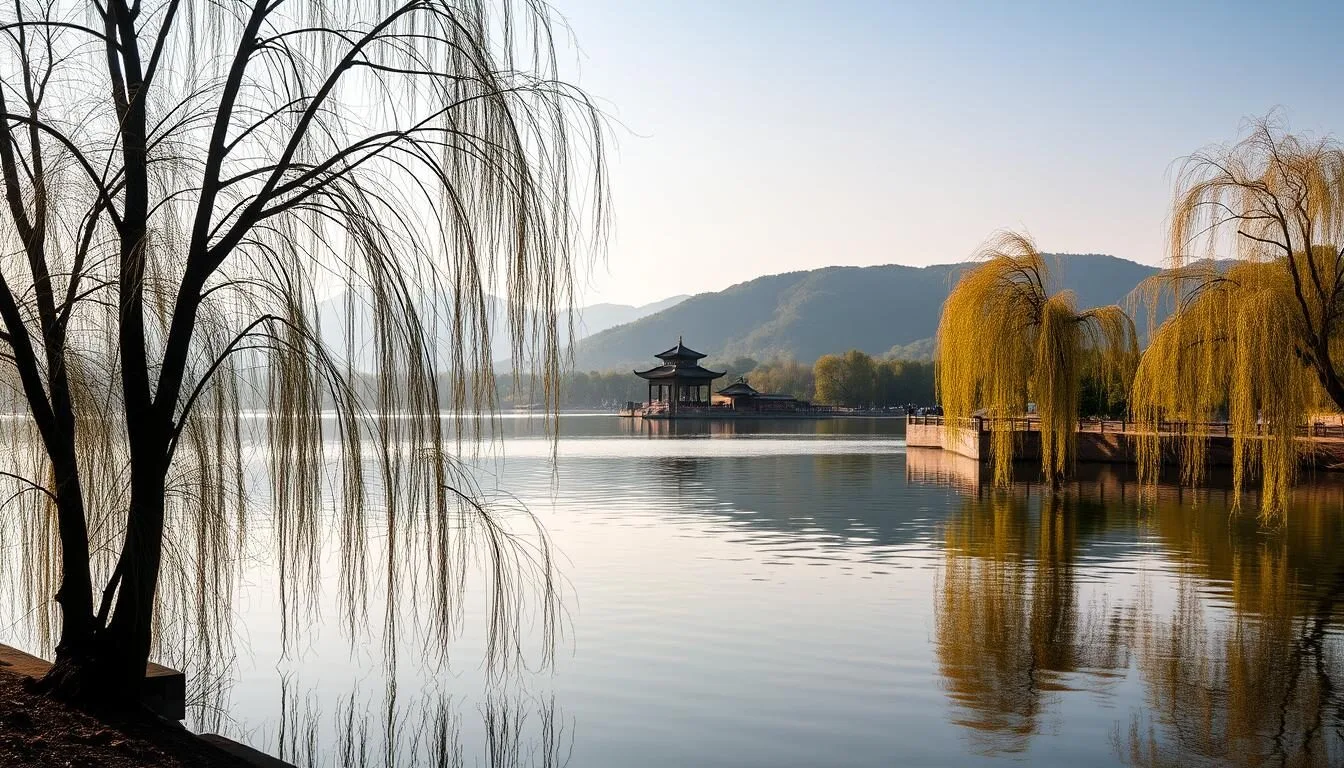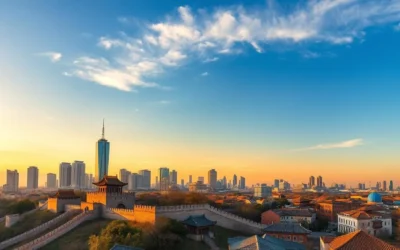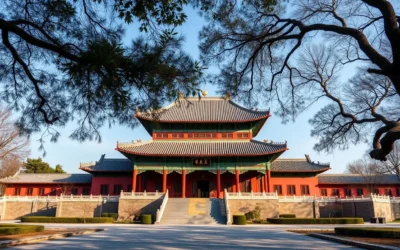✓ Accommodations ✓ Flights ✓ Rental Cars ✓ Tours & Activities
Imagine a place where history and culture blend seamlessly with breathtaking natural landscapes. Hangzhou, a city with over 2,000 years of history, has been a capital during several dynasties, including the Southern Song Dynasty. Known as “Heaven on Earth” since ancient times, this captivating city boasts stunning mountains, springs, lakes, bridges, pagodas, and temples.
As you visit this enchanting place, you’ll discover a perfect blend of natural beauty, historical sites, and modern attractions. From the iconic West Lake to ancient temples and tea plantations, Hangzhou offers unique experiences for all types of travelers. Whether you’re interested in history, culture, or simply enjoying a serene cup of tea, Hangzhou has something for everyone.
Discovering the “Heaven on Earth” – Hangzhou’s Unique Charm
As you step into Hangzhou, you’re immediately enveloped in the city’s unique charm, a blend of natural beauty and rich history. The city’s landscape is characterized by the seamless integration of nature and urban development, particularly around West Lake, where lush trees and plants blend with small shops, creating a harmonious balance between the natural and the built environment.
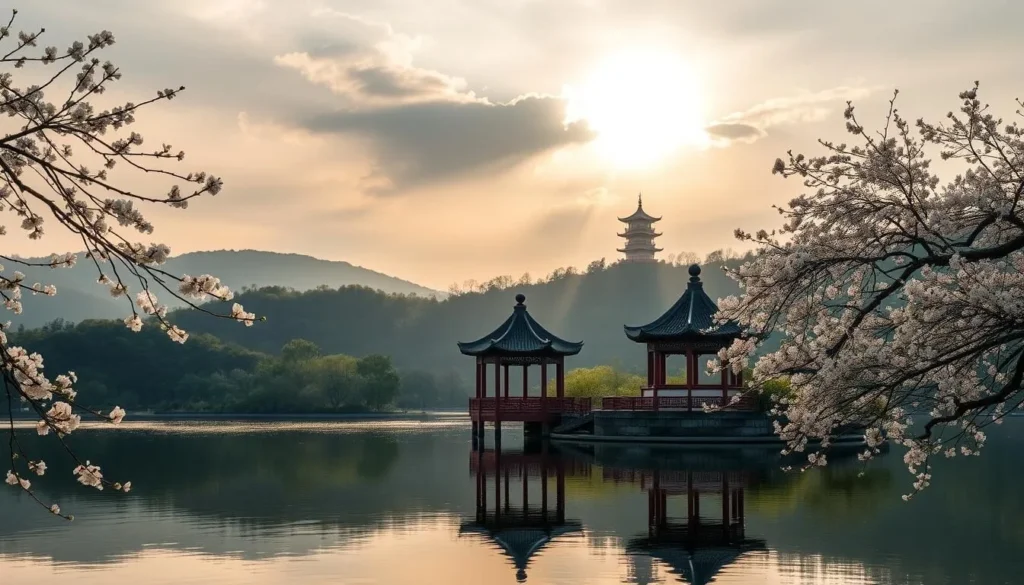
A Brief History of Hangzhou
Hangzhou’s history stretches back over 2,000 years, with its origins dating back to the Qin Dynasty. The city flourished during the Southern Song Dynasty (1127-1279), when it served as the capital and became a center of culture, art, and philosophy. Its strategic location at the southern terminus of the Grand Canal contributed significantly to its prosperity, making it a crucial hub for trade and commerce.
The city’s rich history is evident in its many historical structures and cultural artifacts, showcasing its influence on Chinese culture. Hangzhou’s history during the Song Dynasty is particularly noteworthy, as it was a period of significant cultural and economic growth.
| Dynasty | Significance | Notable Features |
|---|---|---|
| Qin Dynasty | Origins of Hangzhou | Initial development as a strategic location |
| Song Dynasty | Capital of Southern Song | Cultural and economic prosperity |
| Qing Dynasty | Continued cultural significance | Artistic and literary advancements |
Why Hangzhou Is Called “Heaven on Earth”
Hangzhou earned its “Heaven on Earth” nickname due to its breathtaking natural beauty and harmonious blend of mountains, waters, gardens, and historical structures. West Lake, a central feature of the city, is a prime example of this blend, offering serene landscapes and picturesque views. The lake’s beauty has been celebrated in Chinese art and literature for centuries, contributing to Hangzhou’s reputation as a place of natural beauty and cultural significance.
Marco Polo’s description of Hangzhou as “the finest and most splendid city in the world” further cemented its international reputation. Today, Hangzhou continues to evolve, maintaining its charm while embracing modern development. The result is a city that offers visitors a unique blend of traditional and contemporary experiences.
The harmonious integration of natural beauty and urban development makes Hangzhou a truly special place. As you explore the city, you’ll discover that its unique charm is not just a product of its history or natural beauty, but a blend of both, creating a captivating experience that leaves a lasting impression.
West Lake – The Crown Jewel of Hangzhou
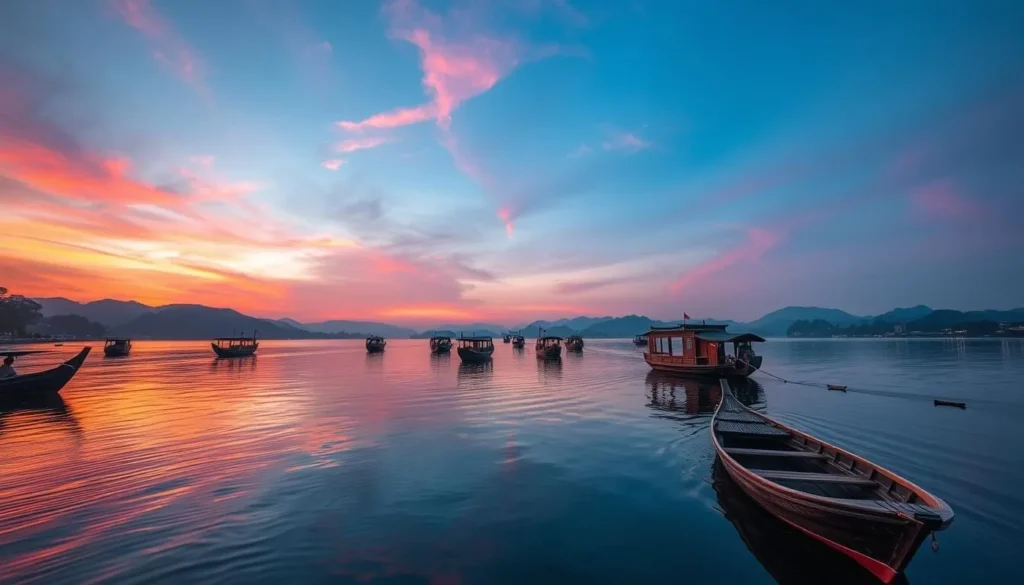
As you step into Hangzhou, you’re immediately drawn to the serene beauty of West Lake, a true gem that has captivated hearts for centuries. West Lake, or Xi Hu, is not just a body of water; it’s an experience that encapsulates the essence of Hangzhou’s natural beauty and rich cultural heritage. As a UNESCO World Heritage Site, West Lake has inspired countless poets, artists, and visitors with its tranquil landscapes and historical significance.
The Ten Scenic Spots of West Lake
West Lake is renowned for its “Ten Scenic Spots,” each offering a unique glimpse into the lake’s natural beauty and cultural importance. These spots include Three Pools Mirroring the Moon, Autumn Moon Over the Calm Lake, and Viewing Fish at Flower Harbor. Each of these sites has its own historical and cultural significance, making them must-visit attractions for anyone exploring West Lake.
The historical significance of these spots is deeply intertwined with the cultural fabric of Hangzhou. For instance, Three Pools Mirroring the Moon is a picturesque scene where three stone towers rise from the lake, reflecting the moonlight and creating a breathtaking spectacle. Similarly, Autumn Moon Over the Calm Lake is a spot that has been celebrated in poetry and art for its serene beauty during the autumn season.
Best Ways to Experience West Lake
Experiencing West Lake is about more than just viewing its beauty; it’s about immersing yourself in it. One of the best ways to do this is by taking a traditional boat cruise across the lake. As you glide across the water, you’ll be surrounded by the lake’s serene scenery and can enjoy the picturesque landscapes from a unique perspective.
Alternatively, you can walk along the Su and Bai causeways, which are lined with trees and offer a leisurely stroll with beautiful views of the lake. Cycling around the lake is another popular option, allowing you to explore the surrounding areas at your own pace. For those looking for a more relaxed experience, a leisurely stroll through the lakeside gardens is a perfect way to enjoy the tranquility of West Lake.
West Lake at Different Seasons
West Lake is a year-round destination, with each season offering a unique impression of West Lake. In the spring, the lake is surrounded by blooming plum and peach blossoms, creating a colorful and vibrant atmosphere. Summer brings the lotus flowers into bloom, adding to the lake’s beauty with their delicate petals and serene presence.
Autumn transforms the landscape with golden and crimson foliage, while winter occasionally brings a serene snow-covered landscape, offering a peaceful and contemplative atmosphere. Regardless of the season, West Lake remains a captivating place that invites visitors to explore and enjoy its beauty.
Lingyin Temple & Feilai Peak – Buddhist Treasures
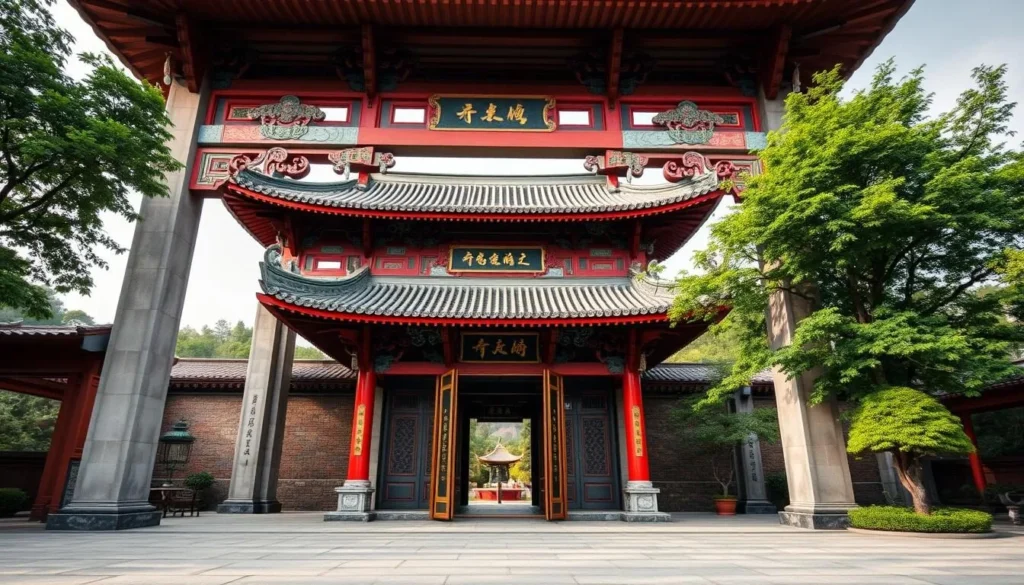
Lingyin Temple, or the Temple of Soul’s Retreat, is a spiritual haven that has been a cornerstone of Buddhism in China since AD 326. As you explore this revered site, you’ll uncover the rich history and architectural splendor that make Lingyin Temple a must-visit destination in Hangzhou.
The Ancient History of Lingyin Temple
Founded by an Indian monk named Huili, Lingyin Temple has a storied past that spans over 1,700 years. The temple’s name, meaning “Temple of Soul’s Retreat,” reflects its role as a spiritual retreat for Buddhists. Throughout Chinese history, Lingyin Temple has been a significant center for Buddhist practices and teachings.
The Ligong Pagoda at the entrance, built in honor of Huili, stands as a testament to the temple’s enduring legacy. As you walk through the temple grounds, you’ll be surrounded by the serene atmosphere and the intricate architectural details that reflect the temple’s rich history.
Buddhist Sculptures at Feilai Peak
Adjacent to Lingyin Temple lies Feilai Peak, renowned for its remarkable collection of Buddhist stone carvings. Dating back to the 10th century, these sculptures depict various Buddhist deities and motifs, showcasing the artistic and religious significance of the site. With over 470 Buddhist statues embedded in the limestone, Feilai Peak is a treasure trove of Buddhist art.
As you explore Feilai Peak, you’ll be struck by the intricate details and the historical value of these ancient carvings. The peak offers a unique glimpse into the evolution of Buddhist art and its importance in Chinese culture.
Spiritual Experience and Visitor Tips
For practicing Buddhists, Lingyin Temple is a sacred site that offers a profound spiritual experience. Visitors can respectfully observe or participate in religious activities, deepening their understanding of Buddhist practices. To make the most of your visit, consider the following tips: plan your visit during the early morning or late afternoon to avoid crowds, wear modest clothing as a sign of respect, and be mindful of the temple’s rules and customs.
Guided tours are available for those seeking a more in-depth understanding of the temple’s history and significance. By taking a guided tour, you’ll gain insights into the temple’s architectural features, such as the Grand Hall housing a 24.8-meter-tall statue of Sakyamuni Buddha carved from 24 pieces of camphor wood.
Longjing Tea Plantations – A Taste of Authentic Chinese Tea Culture
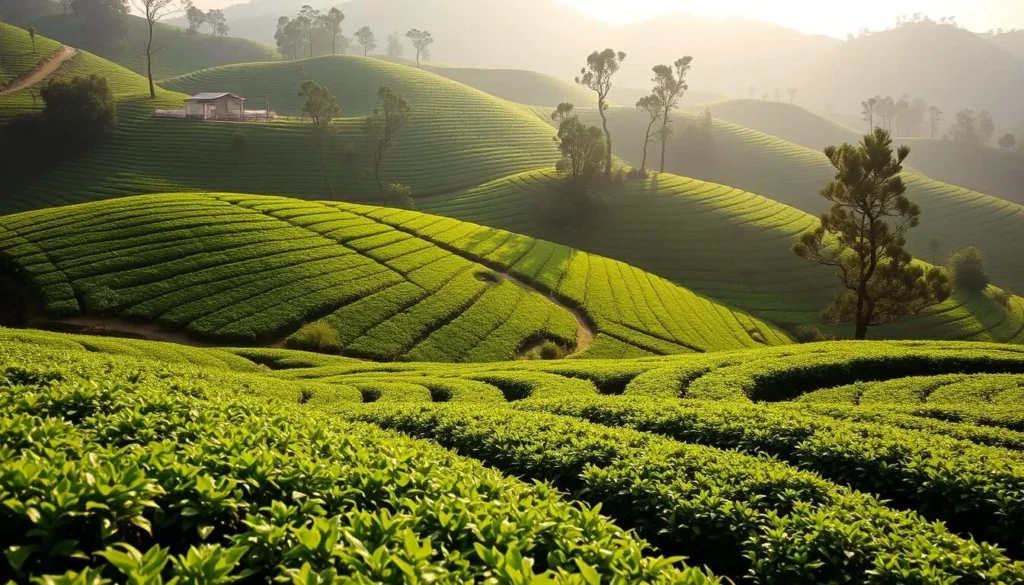
Experience the authentic Chinese tea culture in Hangzhou’s picturesque Longjing Tea Plantations. Longjing, or Dragon Well Tea, is one of China’s most prestigious teas, renowned for its jade color, gentle aroma, mellow taste, and beautiful shape.
Meijiawu and Longjing Villages
The villages of Meijiawu and Longjing are nestled among rolling hills, creating a stunning visual experience with their terraced tea fields. These picturesque landscapes offer a serene escape into the world of tea production. You can wander around the tea terraces, observing the different stages of tea production, from cutting and sorting to drying.
Tea Picking Experience
During the spring harvest, usually in March or April, you can participate in picking tea leaves alongside local farmers. This seasonal tea picking process is a unique experience, allowing you to be a part of the traditional tea production process. Observe the traditional techniques used in Longjing tea production, including hand-roasting in woks, which gives the tea its distinctive flat appearance and nutty flavor.
Tea Tasting and Purchasing Tips
When it comes to tea tasting, appreciating the aroma, color, and flavor of authentic Longjing tea is essential. The tea should have a delicate fragrance and a smooth, refreshing taste. When purchasing Longjing tea, be aware of the different grades and their corresponding prices. Authentic Longjing tea can be identified by its flat shape and the absence of bitterness. Recommended tea houses in the area offer genuine Longjing tea, ensuring a quality purchase.
To buy genuine Longjing tea, visit local tea houses like the ones in Meijiawu or Longjing Village. They offer a wide range of Longjing tea products, and the vendors are knowledgeable about the tea’s origin and quality.
Hefang Street – Shopping and Snacking in Historic Hangzhou
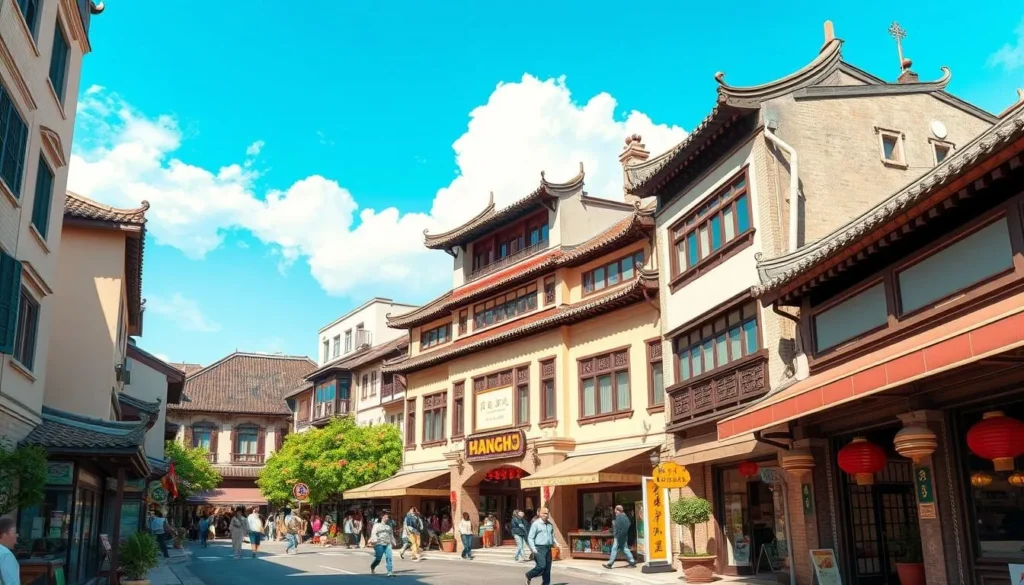
Hefang Street, Hangzhou’s oldest and most famous street, is a treasure trove of traditional Chinese culture. Dating back to the Southern Song Dynasty, this historic place has been a commercial and cultural hub for centuries.
Historical Significance of Hefang Street
Hefang Street is not just any ordinary street; it’s a window into Hangzhou’s rich history. The street’s architecture, with its traditional-style buildings, ornate wooden carvings, and stone pavements, transports visitors back in time. As you walk along this well-preserved ancient street, you’ll feel like you’re experiencing the culture of old China.
Must-Try Local Snacks
One of the highlights of visiting Hefang Street is sampling the local snacks. You’ll find a variety of traditional Hangzhou delicacies, including Dongpo Pork, West Lake Fish in Vinegar Gravy, and Beggar’s Chicken. Be sure to try some sweet treats like Osmanthus Lotus Root, a unique flavor that embodies the local traditional Chinese culinary heritage.
Shopping for Traditional Crafts and Souvenirs
Hefang Street is also renowned for its shops selling traditional crafts and souvenirs. You can watch artisans practicing centuries-old techniques in paper cutting, silk embroidery, fan making, and Chinese medicine preparation. The street offers a range of authentic souvenirs, including silk products, tea sets, paper umbrellas, and locally-made crafts that represent Hangzhou’s culture. When visiting the shops along Hefang Street, you’re not just buying souvenirs; you’re taking home a piece of Hangzhou’s history.
To make the most of your visit to this historic place, consider arriving early in the morning or later in the evening to avoid the crowds while still experiencing the vibrant atmosphere of Hefang Street.
Traditional Chinese Medicine Exploration
Your journey through Hangzhou can include a deep dive into the city’s rich heritage of traditional Chinese medicine. The city is home to numerous institutions and experiences that showcase the history, practices, and cultural significance of traditional Chinese medicine.
Hu Qing Yu Tang – Museum of Traditional Chinese Medicine
The Museum of Traditional Chinese Medicine, known as Hu Qing Yu Tang, is a must-visit destination in Hangzhou. As China’s only state-level Chinese medicine museum, it is housed in a beautifully preserved Qing Dynasty building complex. The museum is more than just a historical site; it’s an immersive experience into the world of traditional Chinese medicine.
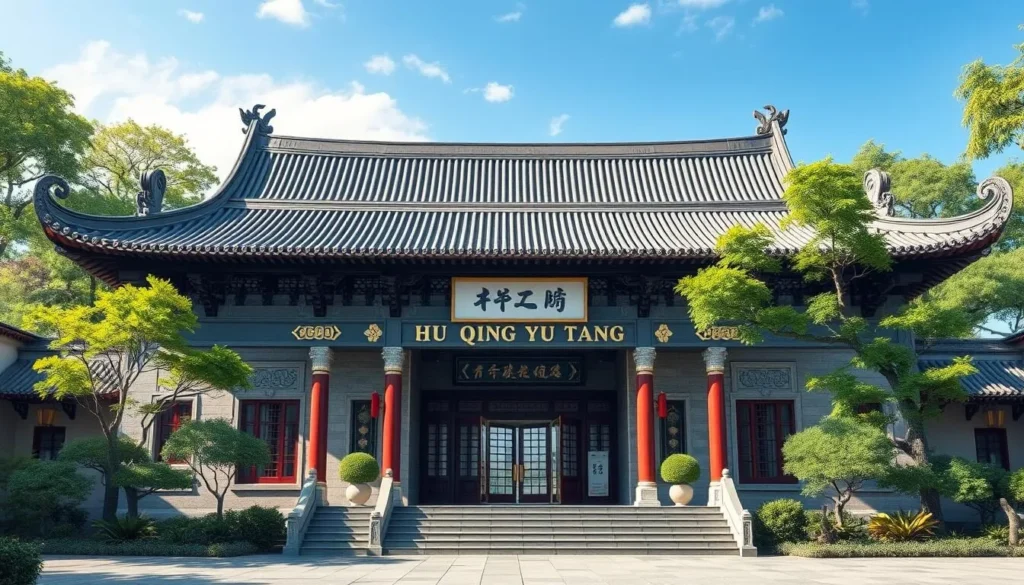
The museum comprises five main parts: an exhibition hall, a hall of medicine preparation, a health care clinic, a sales department, and a restaurant serving medicine diets. As you explore the museum, you’ll gain insights into the 2,000-year history of Chinese medicine, including ancient medical texts, herbal specimens, acupuncture tools, and diagnostic instruments.
You can observe traditional medicine preparation techniques in the museum’s functioning pharmacy, where herbs are still weighed, cut, and processed using centuries-old methods. This hands-on approach to preserving ancient practices is both educational and fascinating.
Chinese Medicine Experiences for Visitors
Visitors to Hu Qing Yu Tang can enjoy a range of interactive experiences. These include pulse diagnosis demonstrations, herbal tea tastings, and consultations with traditional Chinese medicine practitioners. You can also dine at the museum’s medicine diet restaurant, where therapeutic foods are designed according to Chinese medicine principles.
For those seeking a deeper understanding, the museum offers specialized tours and workshops. These programs cover topics from herbal identification to basic acupressure techniques, providing a comprehensive insight into traditional Chinese medicine practices.
Architectural Marvels of Hangzhou
As you explore Hangzhou, you’ll discover a wealth of architectural marvels that showcase the city’s rich heritage. From historic residences to ancient pagodas, Hangzhou’s architecture is a testament to its long history and cultural significance.
Hu Xueyan’s Former Residence – The Top Mansion in Jiangnan
Hu Xueyan’s Former Residence is one of the finest examples of Qing Dynasty residential architecture in China. Built by the richest businessman of the late 19th century, this mansion is renowned for its blend of traditional Chinese and Western elements. The residence features intricate wood carvings, stone sculptures, and China’s largest private garden rock formation.
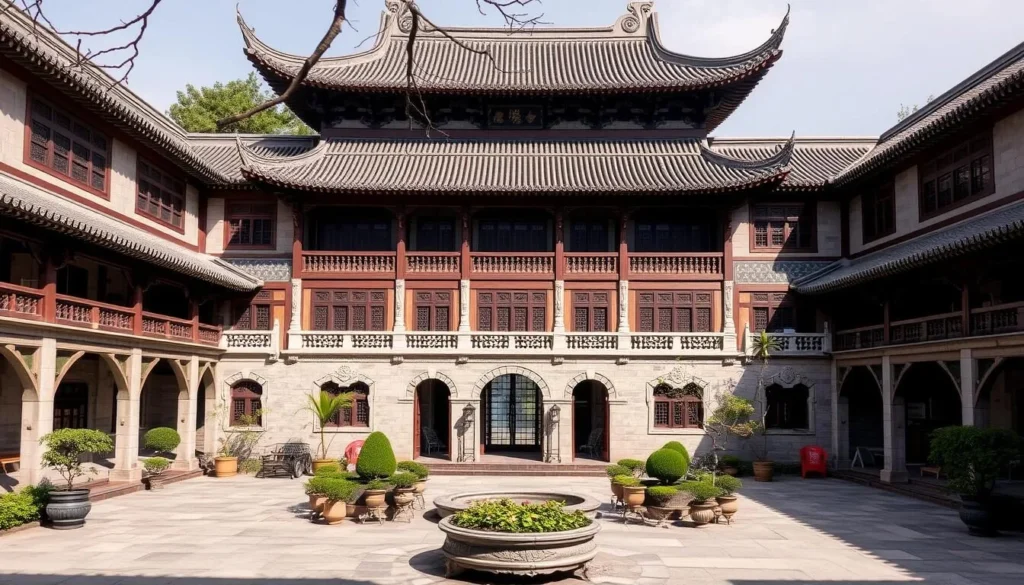
The compound is surrounded by a high enclosure wall, giving it a sense of mystery. Upon entering, the layout is clearly divided along a central axis, showcasing the traditional Chinese architectural style. The Zhi Garden on the west side is particularly noteworthy, with its unique sightseeing route made up of intricately arranged fake rocks.
Hu Xueyan, a prominent banker and merchant, played a significant role in the economic and social changes of late imperial China. His life story, reflected in the grandeur of his former residence, offers insights into the history of the period.
Six Harmonies Pagoda
The Six Harmonies Pagoda, also known as Liuhe Pagoda, is an architectural marvel dating back to 970 AD. This pagoda is unique in its structure, with 13 visible stories outside but only 7 actual floors inside. Originally built to calm the tides of the Qiantang River, it served both as a religious structure and a navigational aid.
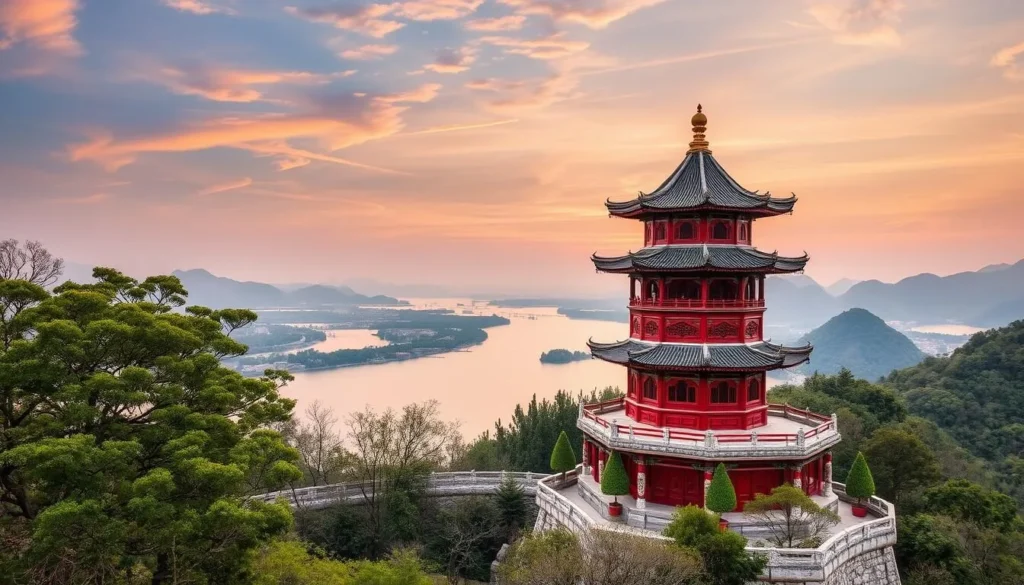
Visiting the Six Harmonies Pagoda during the Mid-Autumn Festival is highly recommended, as it offers a spectacular view of the Qiantang River tidal bore, one of the world’s largest tidal phenomena. The pagoda’s historical significance and architectural uniqueness make it a must-visit attraction in Hangzhou.
The pagoda’s design reflects the ingenuity of ancient Chinese architecture, balancing functionality with religious significance. Its enduring presence is a testament to the architectural prowess of the time.
Night Entertainment in Hangzhou
Experience the magic of Hangzhou at night, with a variety of shows, cruises, and cultural performances to choose from. The city’s vibrant nightlife is a perfect blend of traditional culture and modern spectacles, ensuring an unforgettable experience.
Enduring Memories of Hangzhou Show
The “Enduring Memories of Hangzhou” show, formerly known as “Impression West Lake,” is a world-class performance directed by the renowned filmmaker Zhang Yimou. Staged directly on West Lake, this spectacular show tells the legendary love story of the White Snake through music, light, and dance.
The show’s staging is a technical marvel, with platforms built just below the water’s surface and innovative lighting that transforms the lake into a magical performance space. Performers appear to walk on water, creating an enchanting atmosphere.
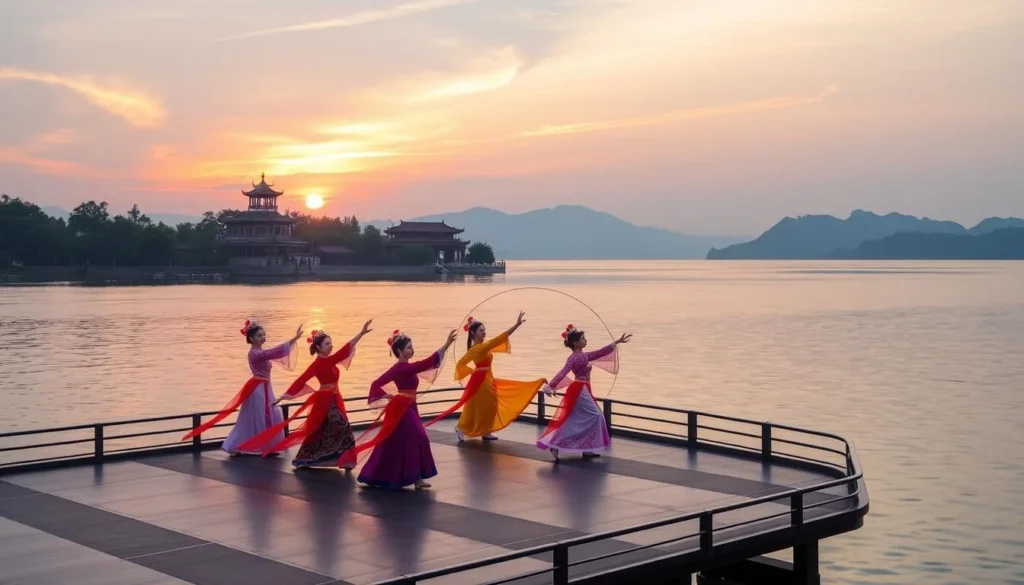
Hangzhou City Balcony – Spectacular Night Views
The Hangzhou City Balcony is a premier observation deck offering panoramic night views of the city skyline and Qiantang River. The state-of-the-art light shows illuminating the cityscape make it a must-visit attraction.
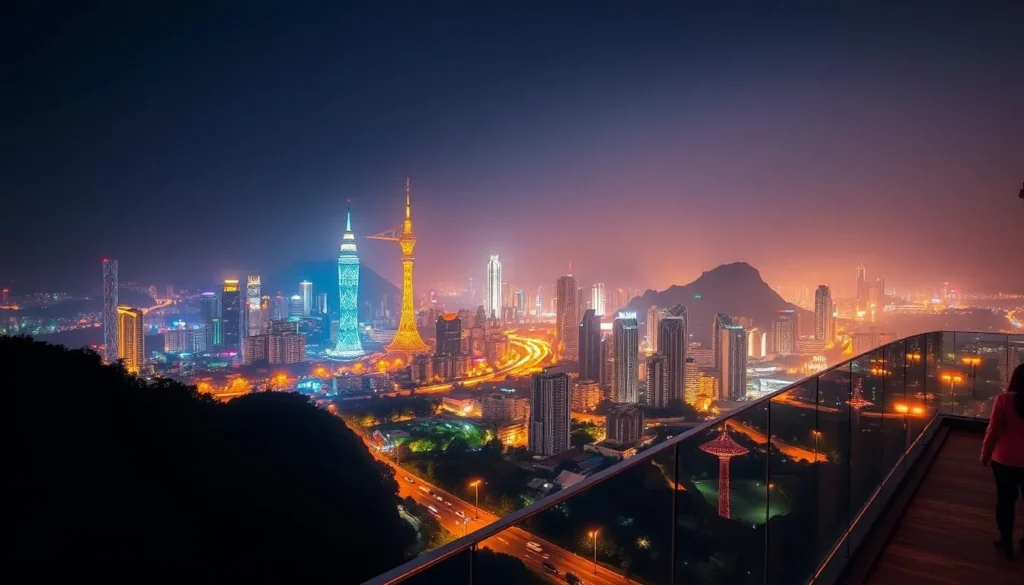
In addition to these highlights, Hangzhou offers other evening entertainment options, including night cruises on West Lake, cultural performances at traditional tea houses, and the vibrant bar scene in areas like Nanshan Road. Whether you’re interested in history, culture, or simply enjoying the city’s ambiance, Hangzhou’s night entertainment scene has something for everyone.
Water Experiences in and around Hangzhou
Hangzhou’s waterways are a testament to the city’s rich history and natural beauty. The city offers a variety of water-based experiences that showcase its historical and natural connections to its waterways.
Beijing-Hangzhou Grand Canal Cruise
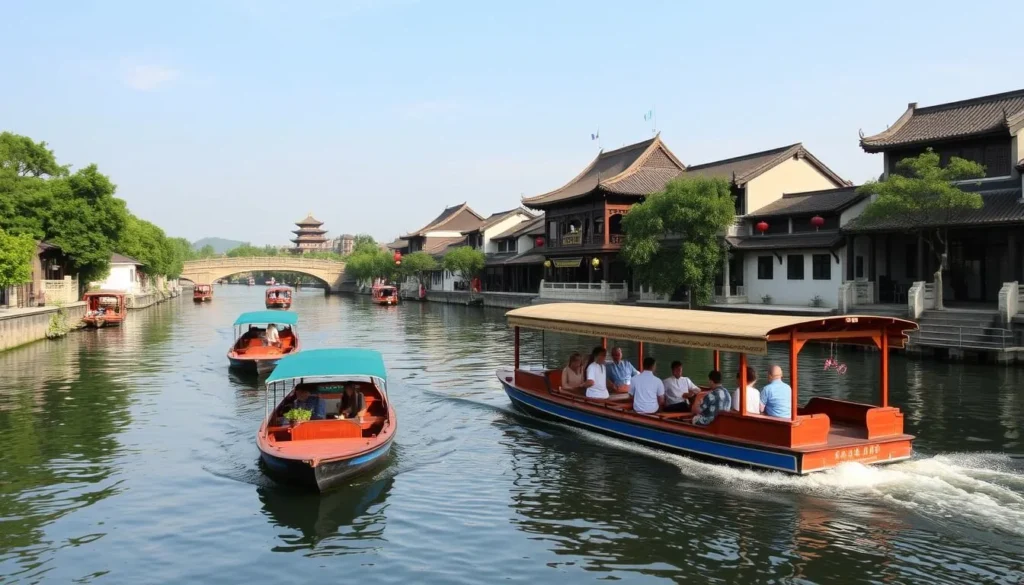
The Beijing-Hangzhou Grand Canal is a 1,400-year-old waterway and a UNESCO World Heritage Site. It’s the world’s oldest and longest man-made canal, offering a unique glimpse into China’s rich history. You can choose from three types of boat experiences: economical water buses for just CNY3 per person for a one-way trip, mid-range tour boats with commentary for around CNY30, and luxury night cruises that combine the Grand Canal and Qiantang River routes.
Boarding at Wulinmen Pier and alighting at Gongchen Bridge Pier is highly recommended. After disembarking, you can explore the Qiaoxi Historic and Cultural Block and Xiaohe Zhijie, immersing yourself in the local culture and history.
Qiantang River Night Cruises
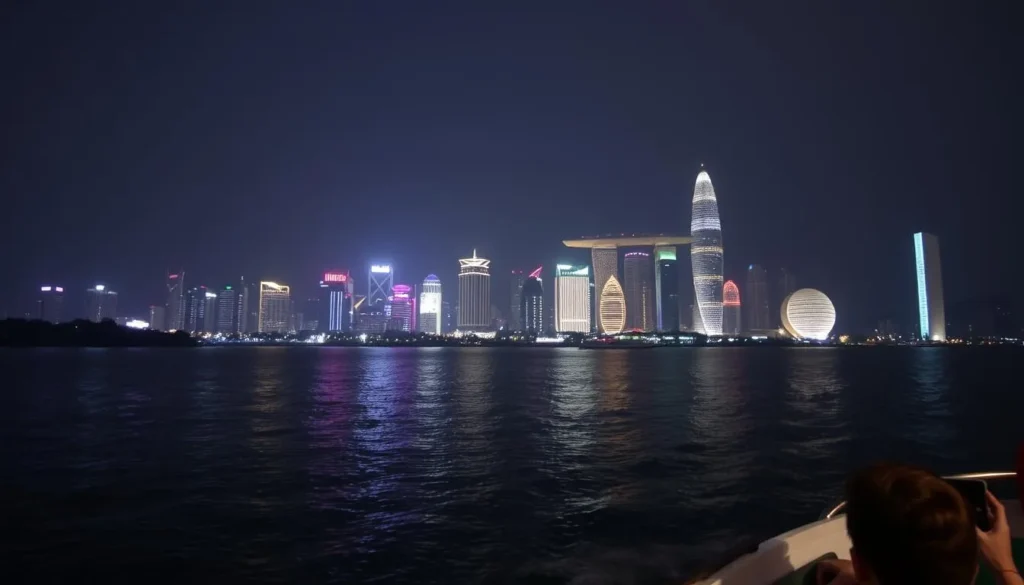
Qiantang River night cruises offer a spectacular view of Hangzhou’s illuminated skyline. During certain times of the year, you may also witness the famous Qiantang River tidal bore, a natural phenomenon that attracts visitors from around the world.
Thousand Islets Lake

Thousand Islets Lake, also known as Qiandao Lake, is a magnificent man-made lake featuring 1,078 islands of various sizes. Created when a valley was flooded for a hydroelectric dam project, the lake offers a range of water activities, including yacht cruises, fishing, and swimming. You can also explore the mysterious underwater ancient city of Shi Cheng (Lion City) through glass-bottomed boats or diving tours.
Hangzhou, China: Best Things to Do – Top Picks for Nature Lovers
For those who love nature, Hangzhou is a paradise with its lush wetlands, beautiful botanical gardens, and majestic mountain landscapes. The city’s diverse ecosystems make it an ideal destination for outdoor enthusiasts and those looking to connect with nature.
Xixi National Wetland Park
Xixi National Wetland Park is China’s first national wetland park, covering an impressive 2,800 acres. This urban wetland combines natural landscapes with traditional Chinese water town elements, offering a unique experience for visitors. You can explore the park’s network of streams, ponds, and islands via traditional wooden boats, taking in the serene scenery and spotting local wildlife.
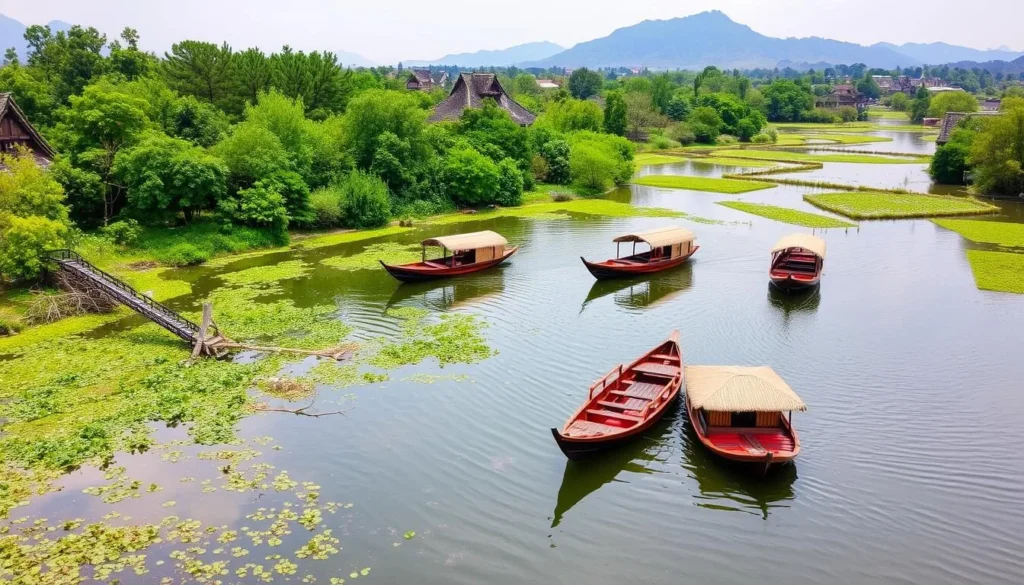
The park is home to over 1,800 animal and plant species, making it a haven for nature lovers. Seasonal attractions include the beautiful plum blossoms in winter, exciting dragon boat races during the Dragon Boat Festival, and the magical “flying snow” phenomenon of reed catkins in late autumn.
Prince Bay Park – Seasonal Flower Displays
Prince Bay Park, also known as Taiziwan Park, is West Lake’s premier botanical garden. It is famous for its spectacular seasonal flower displays, particularly the tulip festival in spring. The park’s vibrant flowers create a stunning scenery, making it a must-visit destination during your trip to Hangzhou.
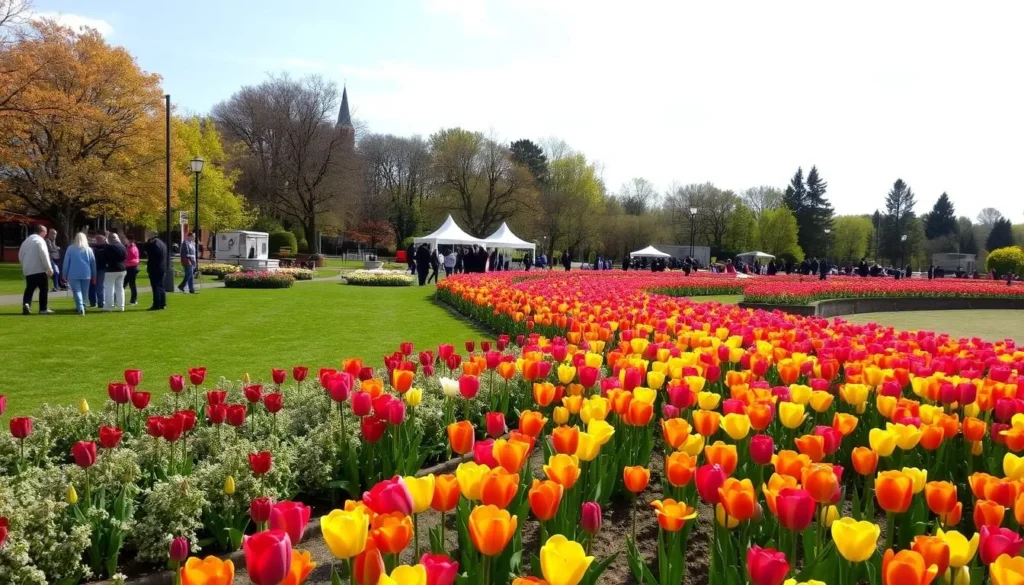
Whether you’re taking a leisurely tour or simply enjoying the water features, Prince Bay Park offers a beautiful place to relax and unwind. Its seasonal flower displays are a highlight of Hangzhou’s natural beauty, attracting visitors from all over.
In addition to Xixi National Wetland Park and Prince Bay Park, Hangzhou offers many other natural attractions for outdoor enthusiasts. These include hiking trails on Baoshi Mountain, bird watching at West Lake, and exploring the bamboo forests near Lingyin Temple, making Hangzhou a great place for a nature-filled trip.
Cultural Immersion in Hangzhou
Hangzhou offers a rich cultural experience, allowing visitors to immerse themselves in Chinese history, art, and traditions. The city is home to numerous cultural landmarks and institutions that showcase its heritage.
China National Tea Museum
The China National Tea Museum, located in the southwest of West Lake, is a must-visit for anyone interested in tea culture. As the world’s first museum dedicated to tea, it features comprehensive exhibits on tea’s 4,700-year history in China, traditional processing methods, and cultural significance. Visitors can experience traditional tea ceremonies, sample various tea varieties, and explore the surrounding tea plantations.
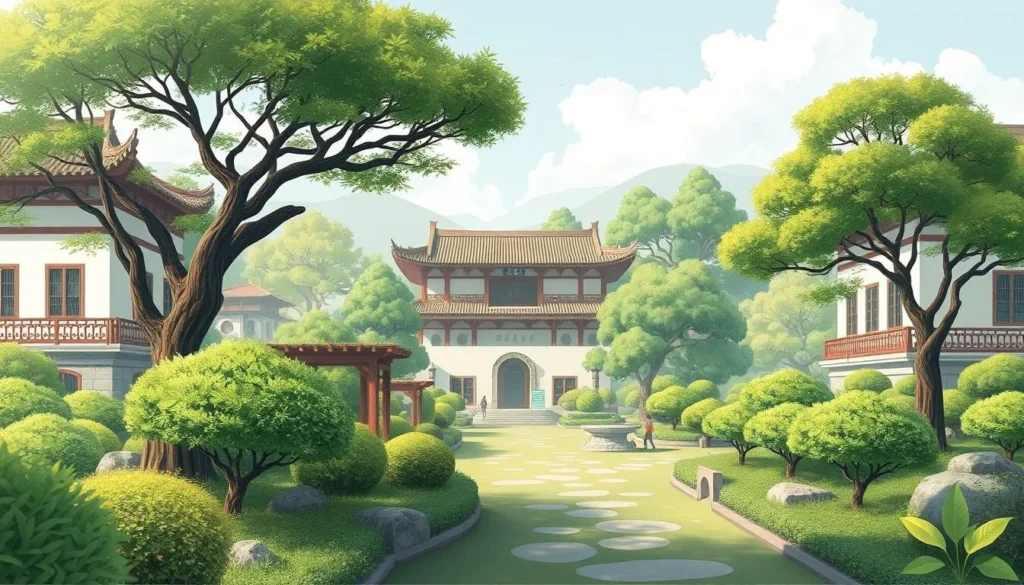
Zhejiang Provincial Museum
The Zhejiang Provincial Museum boasts an extensive collection of over 100,000 cultural relics, including renowned celadon porcelain from the region, ancient bronze artifacts, calligraphy, and paintings. This museum provides a deep insight into the history and culture of Zhejiang Province.
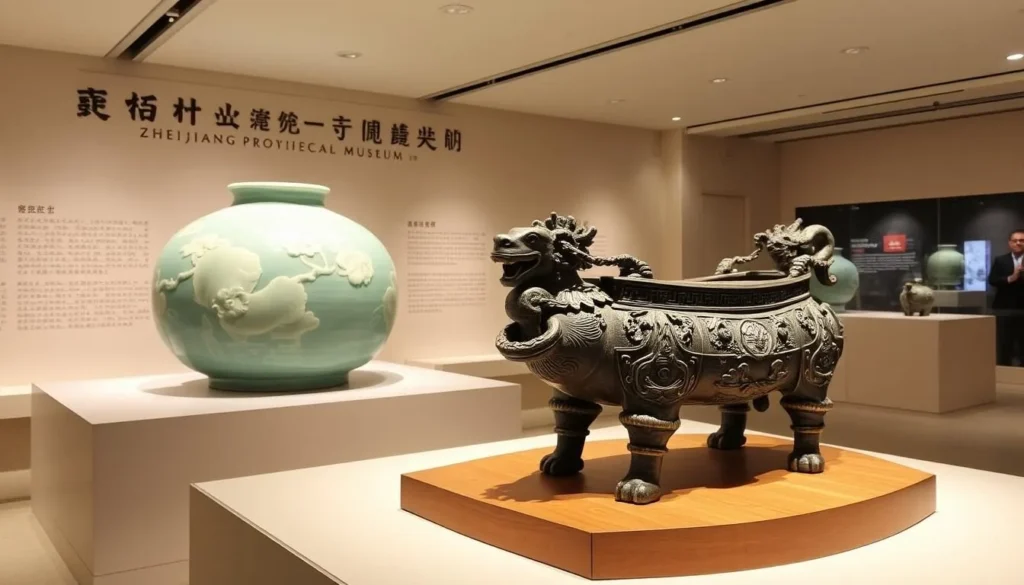
Song Dynasty Town
Song Dynasty Town, also known as Songcheng, is China’s first large-scale theme park focused on historical culture. It recreates the atmosphere of Hangzhou during its golden age as the Southern Song Dynasty capital. Visitors can enjoy the spectacular “Romance of the Song Dynasty” performance, watch traditional craft demonstrations, rent period costumes, and experience recreations of ancient festivals and customs.
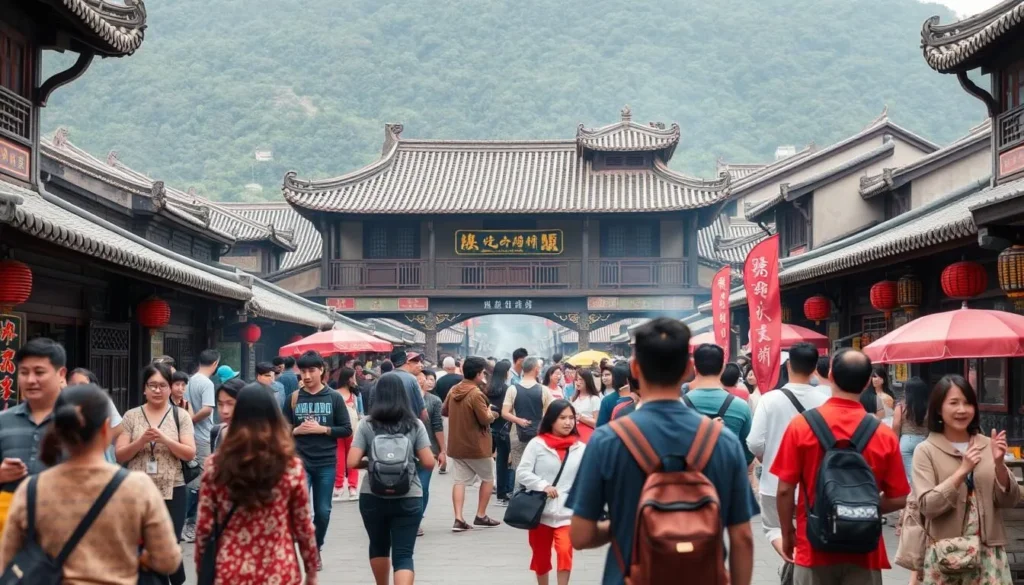
Zen Experiences in Hangzhou
In the heart of Hangzhou lies a world of Zen experiences, waiting to be discovered. You can immerse yourself in the serene atmosphere of ancient temples, participate in meditation sessions, and enjoy traditional vegetarian meals.
Faxi Temple – Photography and Inner Peace
Faxi Temple, also known as Shangtianzhu Faxi Monastery, is a must-visit destination for those seeking Zen experiences in Hangzhou. Located at No.338 Tianzhu Road, Xihu District, this temple is renowned for its spiritual significance and picturesque surroundings.
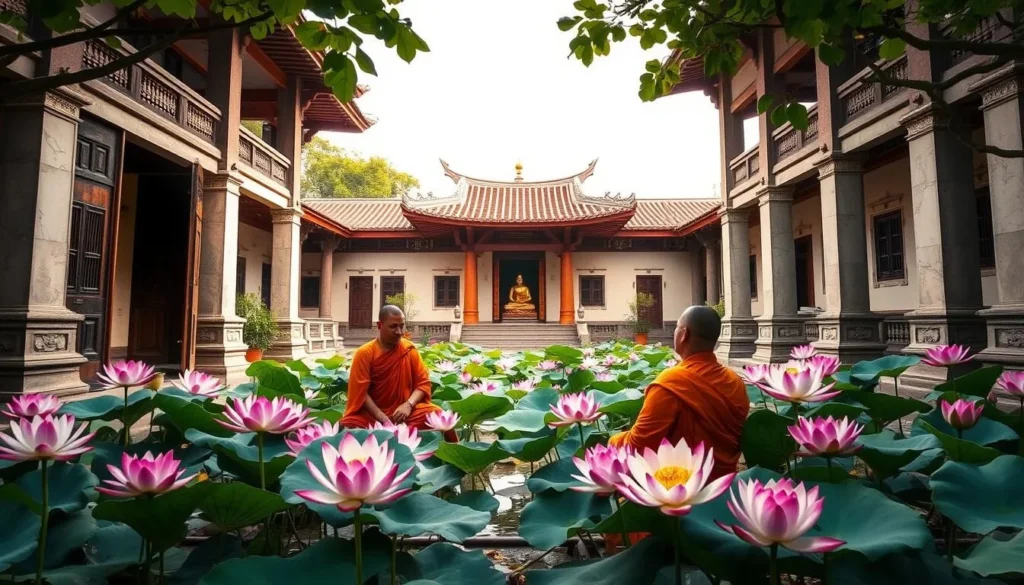
The temple’s “Do Not Seek Outside” plaque has become an Instagram-worthy spot, conveying a profound Buddhist philosophy that encourages introspection. With a history spanning over a thousand years, Faxi Temple offers a unique blend of spirituality and photography opportunities.
You can participate in meditation sessions, savor vegetarian meals at the temple restaurant, and explore the serene corridors and courtyards. The temple’s architecture, which follows the natural contours of the mountain, creates a peaceful ambiance that soothes the mind and soul.
Other Zen Temples Around West Lake
Apart from Faxi Temple, Hangzhou is home to several other significant Zen temples around West Lake. You can visit Yongfu Temple, known for its ancient ginkgo trees, Jingci Temple, famous for its evening bell-ringing ceremony, and Tiantai Temple, nestled in the mountains.
When visiting these temples, it’s essential to respect Buddhist practices and traditions. Dress modestly, and be mindful of your surroundings to ensure a peaceful experience for yourself and others.
Authentic Water Towns Near Hangzhou
The water towns near Hangzhou offer a tranquil escape, rich in history and traditional Chinese architecture. These ancient settlements, built around networks of canals and waterways, have preserved their historical charm and way of life, making them perfect destinations for those seeking an authentic cultural experience.
Wuzhen Water Town
Wuzhen Water Town is a well-developed tourist destination, divided into East and West zones. The West Zone preserves traditional crafts and lifestyles, while the East Zone offers modern amenities and nightlife. With its charming historic scenery, Wuzhen is perfect for photography, especially during spring and autumn. Avoid visiting at noon in summer to escape the heat.
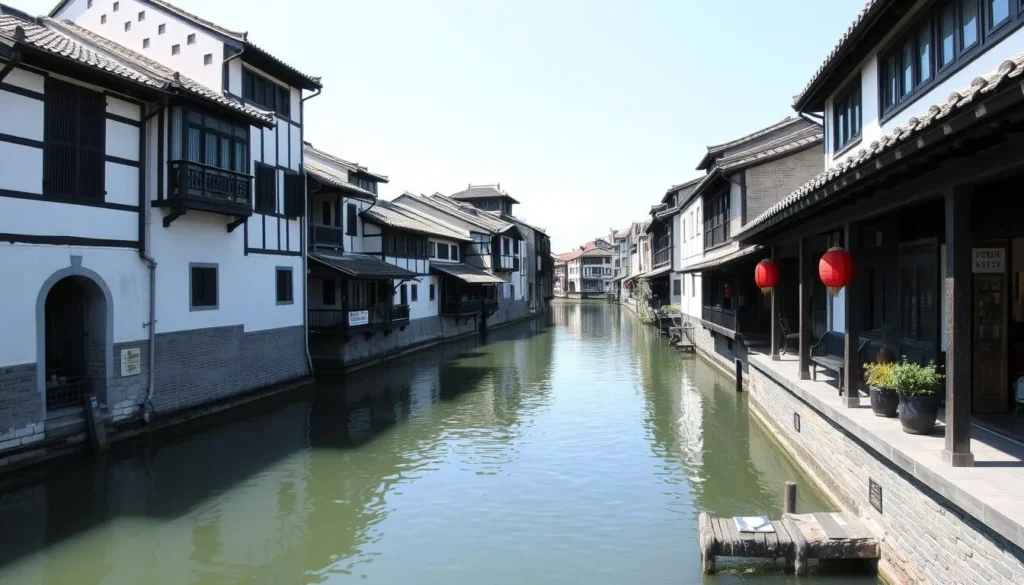
Xitang Water Town
Xitang Water Town is known for its distinctive covered corridors (langpeng) that stretch for over a kilometer along its waterways. These corridors provide shelter during rain and create a unique architectural feature. Xitang offers a peaceful evening ambiance, making it an ideal destination for those seeking relaxation.
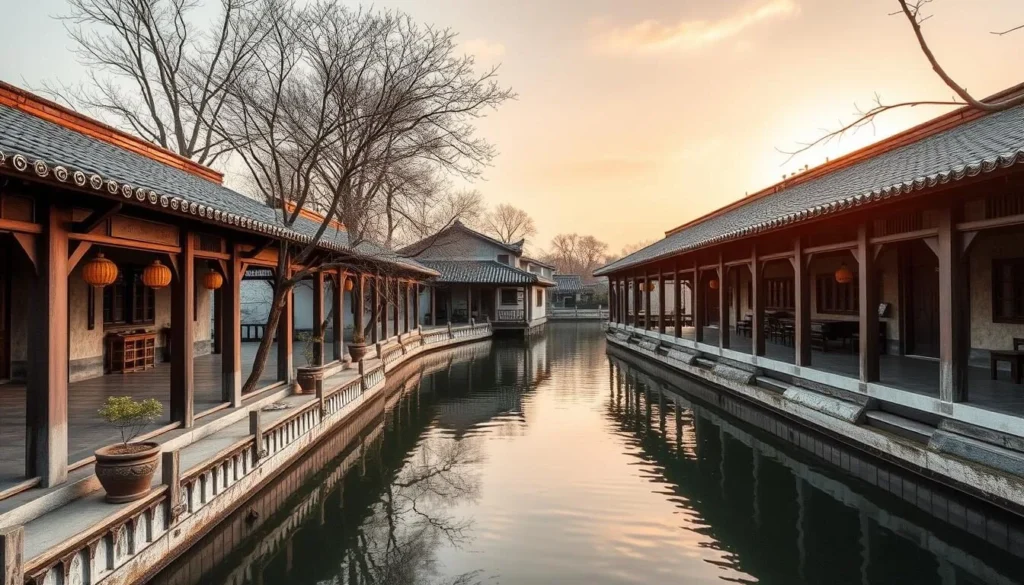
Nanxun Water Town
Nanxun Water Town is the least commercialized and most authentic of the water towns. It features a fascinating blend of traditional Chinese and Western architectural styles, reflecting the influence of wealthy merchants who incorporated European elements into their homes. Nanxun offers an authentic local life experience and unique cultural fusion.
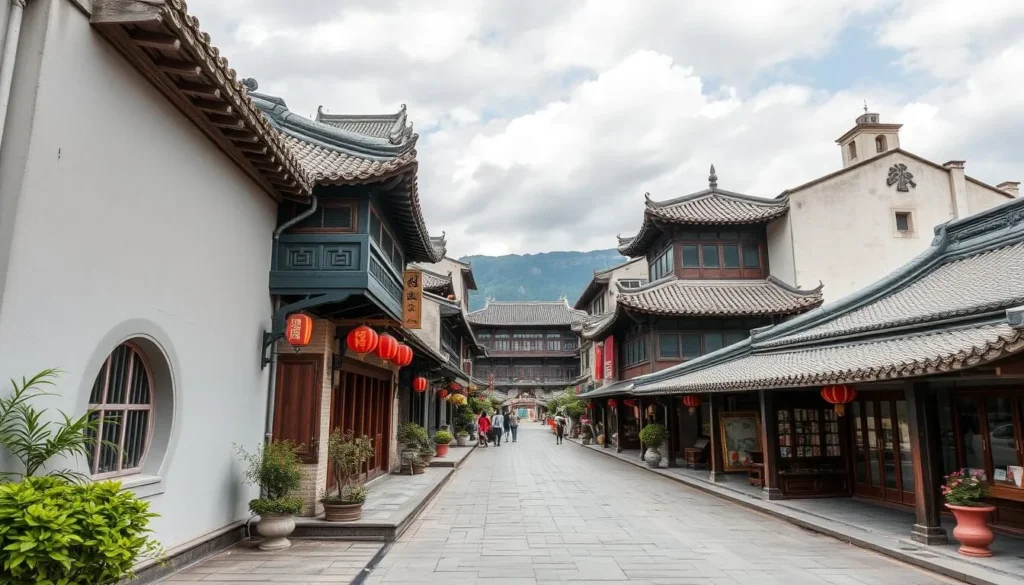
Each of these water towns offers a different atmosphere and experience. Wuzhen is ideal for its well-developed tourism infrastructure, Xitang for its peaceful evening ambiance, and Nanxun for its authentic local life and cultural fusion. Visitors can easily reach these towns from Hangzhou, and it’s recommended to spend at least a day exploring each location. Whether to visit independently or with a guided tour depends on personal preference, but both options provide a rich and rewarding experience.
Qiaoxi Conservation Area – Museums and History
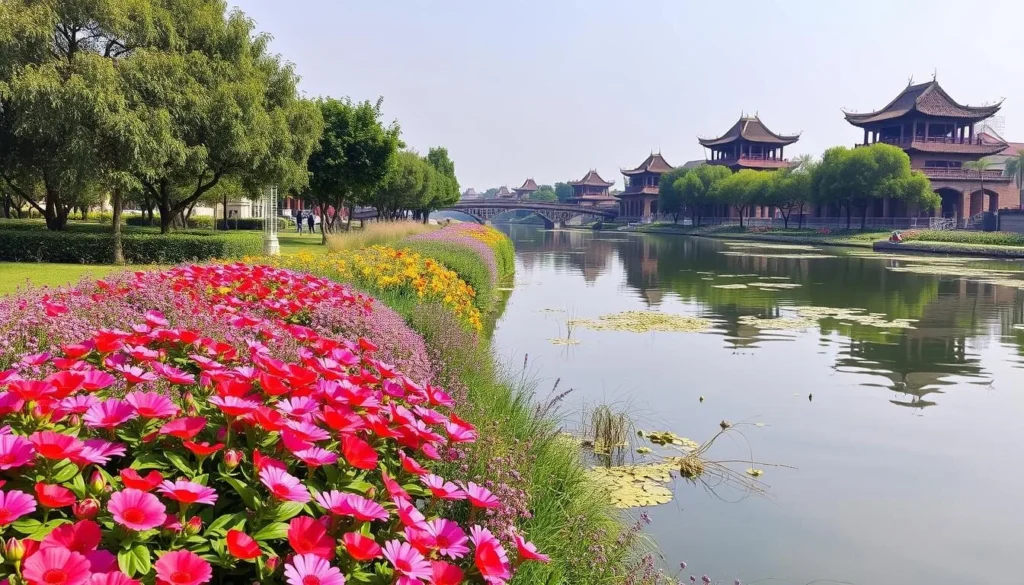
As you explore Hangzhou, you’ll discover the Qiaoxi Conservation Area, a revitalized historical district that showcases the city’s rich heritage. This cultural gem is nestled along the Grand Canal and offers a unique city walk experience that combines history, architecture, and a rich array of museums.
China Umbrella Museum and Other Specialty Museums
The Qiaoxi Conservation Area is home to several fascinating museums, including the China Umbrella Museum and the China Museum of Knives, Scissors & Swords. The China Umbrella Museum showcases the 2,000-year history of Chinese umbrella making, featuring a collection that ranges from ancient oil-paper parasols to modern designs. Visitors can witness demonstrations of traditional crafting techniques, providing a deep dive into this aspect of Chinese culture and craftsmanship.
Other specialty museums in the area include the China Museum of Knives, Scissors & Swords, which displays the evolution of cutting tools and weapons, and the Grand Canal Museum, which documents the canal’s 1,400-year history. Each museum is housed in beautifully restored historical buildings, adding to the overall cultural experience.
Gongchen Bridge and Historical Architecture
A highlight of the Qiaoxi Conservation Area is the historic Gongchen Bridge, a stone arch bridge dating back to the Ming Dynasty. This iconic landmark serves as a viewing platform over the Grand Canal, offering stunning views of the surrounding area. The conservation area preserves architectural styles from different periods, including late Qing Dynasty shophouses, Republican-era industrial buildings, and traditional waterside warehouses that have been repurposed as cultural spaces.
Visitors can take a recommended walking route through the Qiaoxi area, connecting the museums, historical buildings, and modern amenities like craft workshops, boutique shops, and canal-side cafes. This self-guided tour allows you to absorb the history and culture of the area at your own pace, making for a memorable and enriching experience.
Culinary Adventures in Hangzhou
In Hangzhou, food is not just a meal, it’s an experience that combines local ingredients, traditional techniques, and artistic presentation. As the capital of Zhejiang Province, Hangzhou is renowned for its refined culinary traditions, characterized by light flavors, fresh ingredients, and delicate cooking methods.
Famous Hangzhou Dishes to Try
Hangzhou’s cuisine boasts an array of iconic dishes that you must try. Dongpo Pork, named after the famous poet Su Dongpo, is a must-try, with its tender, braised pork belly that melts in your mouth. Another classic is West Lake Fish in Vinegar Gravy (Xi Hu Cu Yu), where the freshness of the fish is elevated by a delicate vinegar sauce. Beggar’s Chicken, wrapped in lotus leaves and clay, is a testament to the ingenuity of traditional cooking methods, resulting in tender, flavorful chicken. Lastly, Longjing Shrimp, stir-fried with the famous local tea, combines the freshness of the shrimp with the subtle aroma of Longjing tea.
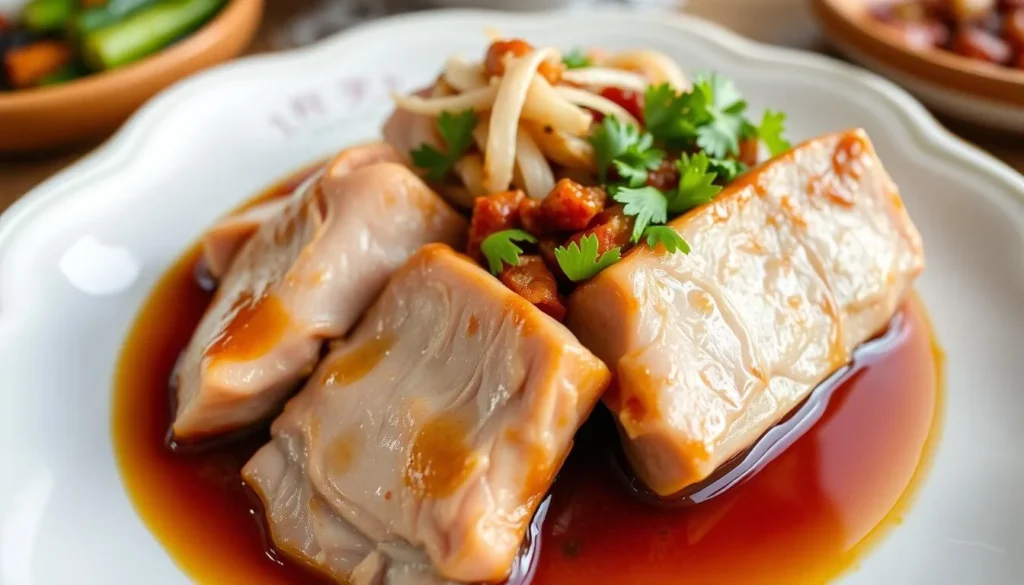
Where to Eat in Hangzhou
For an authentic Hangzhou dining experience, visit historic establishments like Lou Wai Lou, founded in 1848, which has been serving traditional Hangzhou cuisine for generations. Local favorites frequented by Hangzhou residents are also great places to try authentic dishes. Beyond restaurants, explore culinary experiences such as Zhongshan Road Night Market for a taste of local street food, or take a cooking class focusing on local specialties to learn the art of Hangzhou cuisine. For a unique experience, visit a traditional tea house that combines tea tasting with light Hangzhou-style dim sum.
Practical Travel Tips for Visiting Hangzhou
Whether you’re a seasoned traveler or just starting to plan your trip, Hangzhou has much to offer with these practical tips. As you prepare for your journey, understanding the best times to visit, how to get around, and what to include in your itinerary can make all the difference.
Best Time to Visit
The best seasons to visit Hangzhou are spring (March-May) and autumn (September-November). During spring, the plum and peach blossoms create a picturesque landscape, while autumn brings pleasant weather and colorful foliage. Summer can be humid, so it’s advisable to avoid traveling at noon when it can be very hot. Winters may occasionally have cold spells, but they can still be a good time to explore indoor attractions.
Getting Around Hangzhou
Navigating Hangzhou city is relatively easy thanks to its efficient public transportation system. The extensive metro network and convenient public buses make it simple to get around. For tourists, options like the Tourism Bus Y1-Y9 routes connect major attractions. Around West Lake, you can use electric shuttle buses, rent boats, or utilize the popular bike-sharing system, perfect for cycling the flat terrain.
Recommended Itineraries
For a trip to Hangzhou, consider your duration of stay. A one-day tour could focus on West Lake and Lingyin Temple. For a three-day visit, include tea plantations and water towns. A five-day tour allows for a deeper exploration, including day trips to nearby attractions. Your tour should be tailored to your interests, whether it’s history, nature, or cultural experiences.
| Duration | Itinerary Highlights |
|---|---|
| 1 Day | West Lake, Lingyin Temple |
| 3 Days | Tea Plantations, Water Towns |
| 5 Days | Day trips to nearby attractions |

Conclusion
As you conclude your journey through Hangzhou, it’s clear that this city is a treasure trove of natural beauty, cultural heritage, and modern development. Hangzhou offers experiences for every type of traveler: nature lovers can enjoy West Lake and the surrounding mountains, history enthusiasts can explore ancient temples and the Grand Canal, culture seekers can immerse themselves in tea traditions and Buddhist practices, and foodies can savor the refined local cuisine.
The city’s most unmissable experiences include cruising on West Lake, visiting Lingyin Temple, exploring Longjing tea plantations, watching the Enduring Memories show, and strolling through historic streets and water towns. Hangzhou’s nickname “Heaven on Earth” is well-deserved, with its harmonious blend of scenic landscapes, architectural treasures, and cultural experiences that have inspired poets, artists, and travelers for centuries.
We suggest that you consider Hangzhou not just as a day trip from Shanghai but as a destination worthy of several days’ exploration to fully appreciate its diverse attractions and unhurried pace. Venture beyond the most famous sites to discover Hangzhou’s hidden gems, interact with local people, and experience the authentic charm that makes this city a favorite among both Chinese and international tourists. Whether you’re exploring the Qiantang River on a boat or visiting a local museum, Hangzhou is a place that will leave you with unforgettable memories of your trip.
The above is subject to change.
Check back often to TRAVEL.COM for the latest travel tips and deals.
